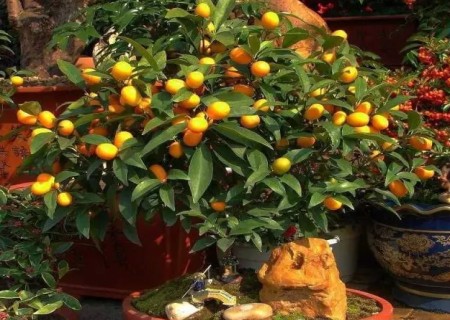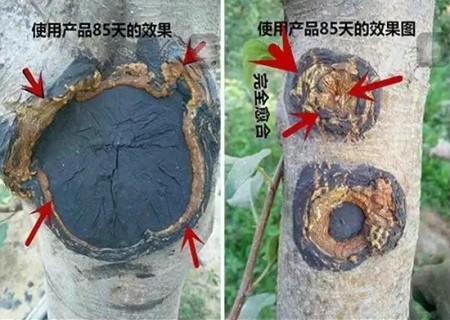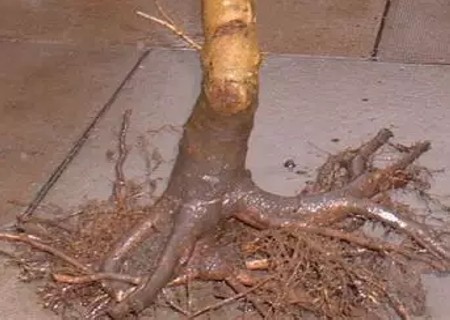The method of inverting pot and changing soil for bonsai of fruit trees
In order to ensure that fruit trees have high appreciation value every year, it is necessary to reasonably choose the frequency and timing of changing pots. If the frequency of changing pots is too high, it will make the branches grow vigorously, resulting in less fruit formation in that year; if the frequency of changing pots is too small, it will deplete the nutrients of the basin soil, and the aging root system will reduce the absorption capacity of water and nutrients, making fruit trees lose their vitality and reduce their appreciation value.

Under normal circumstances, it is more appropriate for fruit trees to change pots every two years. In order to avoid frostbite in winter and malnourishment of flower buds at the end of spring, the best time for bonsai to change pots is usually at the end of the spring freezing period and before the flower buds sprout, which can buy time for the growth of new roots.
Some steps should be followed when changing the basin:
1. In order to prevent the soil balls from falling, the fruit trees that are about to change pots should be watered one day in advance.
2. When trimming the roots, the aged coarse roots and capillary roots should be trimmed to avoid damaging the root tip of the moderate root, because the root tip is the most important part to absorb nutrients and water.
3. The bottom of the new basin should be evenly covered with nutritious soil, and then the soil ball should be put in slowly.
4. When filling the remaining space in the basin with cultivated soil, the methods of step-by-step filling and water seepage filling should be adopted to avoid the damage of root system caused by external force.
Bonsai of fruit trees usually need to be poured out in time every 2 years to replace new nutrient soil. Potted trees with poor fertilizer content or those who have not changed the soil for a long time should be fertilized more. After pouring the basin, it should be watered once to facilitate the growth of the root system.
Each time the basin is changed, the root system of the tree is lifted up so that the soil surface exceeds the basin surface, and the foundation is gradually exposed with daily watering. You can also artificially use bamboo sticks, sticks and so on to gradually remove the soil from the basin until the desired dew effect.
The reason for changing the basin:
The main results are as follows: 1. when the plant grows, the original pot volume is no longer suitable for the requirement of plant growth, so it is necessary to expand the pot volume and increase the root absorption area.
2. The perennial plant grows in the basin, the age is old, the root system grows cross in the basin, crowds each other, affects the new root growth, the ability of absorbing nutrients is significantly weakened, so it is necessary to change the basin, carry on the proper fertilizer culture management, and prune the root system to make the plant grow healthily.
The method of potting:
As the nutrients in the basin soil will be absorbed by fruit trees or leached by frequent watering, it is necessary to pour the basin in time every two or three years to replace the new nutrient soil. After the old soil mass is buckled out of the basin, the old root on the surface of the soil mass and the big root that affects its shape should be cut off. When putting on the basin, you should first mix organic fertilizer and nutritious soil to fill the bottom, then bring the soil mass to the basin, and fill it with basin soil mixed with fertilizer. The pH value of basin soil is generally between 4.5 and 7.5. According to the requirements of different tree species, different nutrient soils rich in organic matter should be allocated, preferably sandy loam rich in humus.
In general, 4 parts of matured pastoral soil, 2 parts of river sand and 1 part of plant ash were mixed well, then ground and screened. The basin soil should be disinfected before use, and a small amount of sulfur powder should be mixed evenly. When changing the soil each time, the suitable pot can be replaced according to the growth range of the fruit tree, the size of the root ball and the need for modeling.
Time: 2019-05-31 Click:
- Prev

Treatment of poor healing of pear grafting ring peeling
Pear trees are generally girdled on main branches, side branches and overgrown branches. When peeling, it is appropriate to cut 2-3 times in a spiral way. When girdling, we should strictly control the peeling width without harming the xylem, the width should be less than 10% of the branch diameter, and the widest width should not exceed 1.0cm. From May to July, too late is not conducive to wound healing.
- Next

Diagram of root filling process of maple bonsai
The root of the plant is the main artistic beauty of the stump bonsai. The defect of the root of the plant when it is young (the root of the potted plant develops on one side) will develop obviously with the increase of time, and the rooting will inevitably be damaged due to various reasons in the process of cultivation, which will affect the ornamental effect of bonsai.
Related
- Fuxing push coffee new agricultural production and marketing class: lack of small-scale processing plants
- Jujube rice field leisure farm deep ploughing Yilan for five years to create a space for organic food and play
- Nongyu Farm-A trial of organic papaya for brave women with advanced technology
- Four points for attention in the prevention and control of diseases and insect pests of edible fungi
- How to add nutrient solution to Edible Fungi
- Is there any good way to control edible fungus mites?
- Open Inoculation Technology of Edible Fungi
- Is there any clever way to use fertilizer for edible fungus in winter?
- What agents are used to kill the pathogens of edible fungi in the mushroom shed?
- Rapid drying of Edible Fungi

